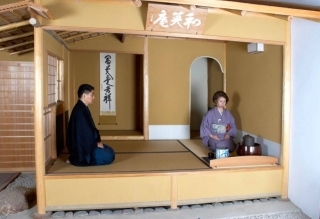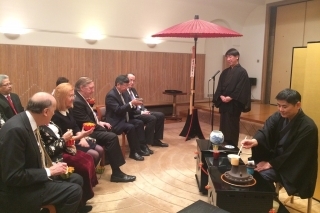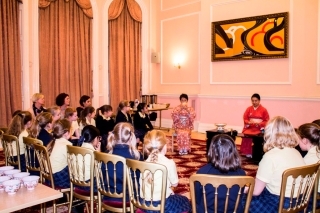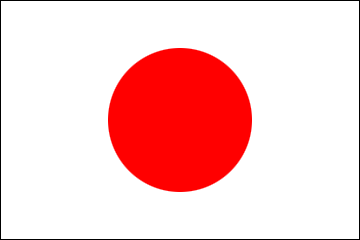Spotlight on…. Tankokai UK Association, Urasenke UK School of Tea
2021/8/4
 Chado demonstration at the British Museum
Chado demonstration at the British Museum
Chado, The Way of Tea, is a Japanese tradition with more than 400 years of history. There are many practitioners not only in Japan, but all over the world. The Urasenke Foundation is one of the oldest chado schools and has an official branch in London that promotes the teachings of The Way of Tea though lectures, demonstrations and lessons.
The Tankokai UK Association is formed mainly of practitioners of the Way of Tea who support Urasenke activities in their communities as well as deepening their knowledge of chado through study groups and training. The UK Association commenced activities in 2009 with chado presentations in schools, and in 2011, Tankokai UK was officially launched in London by Urasenke XV Grand Master SEN Genshitsu.
This month we turn our spotlight on YAMAGUCHI Yasuhiro, representative of the Tankokai UK Association.
The Tankokai UK Association is formed mainly of practitioners of the Way of Tea who support Urasenke activities in their communities as well as deepening their knowledge of chado through study groups and training. The UK Association commenced activities in 2009 with chado presentations in schools, and in 2011, Tankokai UK was officially launched in London by Urasenke XV Grand Master SEN Genshitsu.
This month we turn our spotlight on YAMAGUCHI Yasuhiro, representative of the Tankokai UK Association.
 Chado event at Ambassador's residence
Chado event at Ambassador's residence
 Chado workshop for schools at the Embassy
Chado workshop for schools at the Embassy
What is chado and what does being a practitioner of chado entail?
SEN Rikyu, the founder of chado in the 16th century, said that chado is the simple act of boiling water and making and drinking tea. We regard chado as a refined way of hospitality in the Japanese style.
By practicing chado, we can learn socialising skills and manners. To offer heartful tea and experience to guests, we pay utmost attention to the atmosphere and environment. We can also learn how to move gracefully, for example, how to sit, stand, walk, greet others, and handle objects. Chado also teaches Japan’s traditional customs and values. The sense of beauty is also trained as various art and craft objects are involved in a tea gathering, including scrolls, flowers, ceramics, lacquerware, woodware, metalwork, and textiles. Furthermore, chado provides an opportunity to think about the Japanese identity, which is very powerful knowledge in the global platform. Finally, mutual respect and support, which chado emphasises, lead to a peaceful society.
Is it difficult to practice chado in the UK?
Fortunately we have an official Urasenke branch in London. Kimura-sensei, the head of the branch, has been teaching in Greenwich for the past two decades. Prior to his assignment in the UK, he trained in Kyoto with the former Grand Master, Sen Genshitsu, and his first-hand knowledge and experience are invaluable assets. The branch is open to anybody interested in chado, regardless of prior experience. Regular keiko (class) is held three times a week (currently online), while special training courses and events are organised throughout the year.
How does the Tankokai UK Association support the activities of the Urasenke School of Tea?
Tankokai’s aims are to promote chado to the general public and offer mutual support among its members. We regularly demonstrate the Way of Tea at various institutions and events, such as embassies, museums, schools and corporate offices. When a group is interested in Japanese culture and makes contact with Urasenke, we do our best to visit them and demonstrate chado. If the London Branch is not available, Tankokai gladly meets people to share the joy of matcha. Tankokai also organises study sessions on tea-related subjects, including Japanese sweets, culinary, gardens, and ceramics.
SEN Rikyu, the founder of chado in the 16th century, said that chado is the simple act of boiling water and making and drinking tea. We regard chado as a refined way of hospitality in the Japanese style.
By practicing chado, we can learn socialising skills and manners. To offer heartful tea and experience to guests, we pay utmost attention to the atmosphere and environment. We can also learn how to move gracefully, for example, how to sit, stand, walk, greet others, and handle objects. Chado also teaches Japan’s traditional customs and values. The sense of beauty is also trained as various art and craft objects are involved in a tea gathering, including scrolls, flowers, ceramics, lacquerware, woodware, metalwork, and textiles. Furthermore, chado provides an opportunity to think about the Japanese identity, which is very powerful knowledge in the global platform. Finally, mutual respect and support, which chado emphasises, lead to a peaceful society.
Is it difficult to practice chado in the UK?
Fortunately we have an official Urasenke branch in London. Kimura-sensei, the head of the branch, has been teaching in Greenwich for the past two decades. Prior to his assignment in the UK, he trained in Kyoto with the former Grand Master, Sen Genshitsu, and his first-hand knowledge and experience are invaluable assets. The branch is open to anybody interested in chado, regardless of prior experience. Regular keiko (class) is held three times a week (currently online), while special training courses and events are organised throughout the year.
How does the Tankokai UK Association support the activities of the Urasenke School of Tea?
Tankokai’s aims are to promote chado to the general public and offer mutual support among its members. We regularly demonstrate the Way of Tea at various institutions and events, such as embassies, museums, schools and corporate offices. When a group is interested in Japanese culture and makes contact with Urasenke, we do our best to visit them and demonstrate chado. If the London Branch is not available, Tankokai gladly meets people to share the joy of matcha. Tankokai also organises study sessions on tea-related subjects, including Japanese sweets, culinary, gardens, and ceramics.
Due to the ongoing restrictions many events and activities have been cancelled or postponed. How have the activities of Urasenke and Tankokai UK been affected?
We had to cancel all face-to-face events during the lockdown, but with the relaxation of the restrictions, we are planning several demonstrations and events for autumn and winter. Over the past year and a half, we also used online tools to organise study groups. By using technology, we have actually expanded our reach, and many people joined our online lectures from all over the world.
Matcha has been gaining popularity of late in the UK, both as a drink and as a flavour for sweets and cakes, which in turn provides a great opportunity to introduce chado to a new audience. What in particular would you like to introduce to those new matcha fans?
It is a great pleasure to see matcha gaining popularity here in the UK. We hope it will lead to further interest in Japan in general and the holistic nature of chado. People can gain insight into various aspects of Japan through chado, such as philosophy, history, literature, arts, and culture.
Lastly, what advice do you have for people who are interested in experiencing and learning more in-depth about The Way of Tea?
I recommend they contact the London branch at ukchado@gmail.com. Kimura-sensei will welcome anybody interested to his keiko, and people can enjoy an authentic chado experience. Many of the students started in London without any knowledge, but his kind and patient keiko allowed us to gradually understand the significance of the Way of Tea. Kimura-sensei also gives demonstrations a few times a month at the British Museum (currently suspended). That would be an excellent introductory visit.
We had to cancel all face-to-face events during the lockdown, but with the relaxation of the restrictions, we are planning several demonstrations and events for autumn and winter. Over the past year and a half, we also used online tools to organise study groups. By using technology, we have actually expanded our reach, and many people joined our online lectures from all over the world.
Matcha has been gaining popularity of late in the UK, both as a drink and as a flavour for sweets and cakes, which in turn provides a great opportunity to introduce chado to a new audience. What in particular would you like to introduce to those new matcha fans?
It is a great pleasure to see matcha gaining popularity here in the UK. We hope it will lead to further interest in Japan in general and the holistic nature of chado. People can gain insight into various aspects of Japan through chado, such as philosophy, history, literature, arts, and culture.
Lastly, what advice do you have for people who are interested in experiencing and learning more in-depth about The Way of Tea?
I recommend they contact the London branch at ukchado@gmail.com. Kimura-sensei will welcome anybody interested to his keiko, and people can enjoy an authentic chado experience. Many of the students started in London without any knowledge, but his kind and patient keiko allowed us to gradually understand the significance of the Way of Tea. Kimura-sensei also gives demonstrations a few times a month at the British Museum (currently suspended). That would be an excellent introductory visit.
